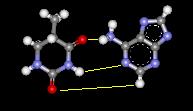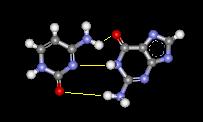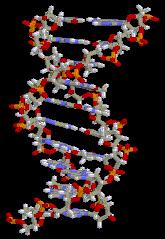


DNA is, in my humble opinion, the most fascinating molecule that exists. It is found in nearly every living cell, and effectively contains all the information which that cell needs to function. The actual structure of DNA was discovered by James Watson and Francis Crick, both of whom received the Nobel Prize for medicine in 1962 due to their discovery.
They knew from X-ray diffraction studies that the molecule had a helical structure, and also through chemical investigation that the molecule contained four bases: adenine (A) , guanine (G) , cytosine (C) and thymine (T) , along with some sugar and phosphate. To view the 2D structure of each of these bases, click on the names.
In a DNA molecule, it is always found that the number of adenine bases is exactly the same as the number of thymine bases, and the number of guanine bases is the same as the number of cytosine bases.
Watson and Crick proposed a structure, which they had pain-stakingly constructed using molecular models, which accounted for the numbers of the bases, and allowed all the atoms in the structure to fit together in a way which was sterically sensible, that is to say that the atoms did not get in each others way. It also allowed hydrogen bonding (click here for information on hydrogen bonding) between bases, which has the effect of stabalising the molecule. This also explained why the numbers of adenosine bases were always the same as the number of thymine bases, and the same for cytosine and guanine numbers. Adenosine and thymine can only form hydrogen bonds to each other, and cytosine and guanine can only form hydrogen bonds to each other (see below). These molecules are, essentially, shaped so that they can only form a bond, albeit a relatively weak one, with their 'base pair'.
|
H-bonding between adenine (left molecule) and thymine
|
 |
|
H-bonding between cytosine (left molecule) and guanine
|
 |
|
Key
|
 |
Knowing this, we can move on to the actual structure of DNA. The bases are actually joined to a 'sugar-phosphate backbone', which is a chain of sugar, specifically D-2-deoxyribose, to which the bases are linked, and inbetween each sugar unit, there is a phosphate group, as shown below.
 |
Watson and Crick proposed that two of these 'polynucleotide' chains came together, and coiled up to form a double helix structure. The chains would be held together by hydrogen bonding between complimentary base-pairs, which means that opposite each A-base there will be a T-base, and opposite each G-base there will be a C-base. This produces a very complex structure, which is shown below in two different forms.
|
The two polynucleotide chains can be seen spiralling
around each other, linked together by the bases. The bases resemble a
ladder. Click
here for an animated GIF which is a very simple representation of
DNA.
|
 |
DNA is organised in a cell such that it is densely packed. For instance, the DNA in one human cell is approximately two metres long if unraveled. The packinh is organised so that ca. 140 base pairs form a clump, around proteins called histones. This structure is known as a nucleosome. Inbetween the nucleosomes is a linker region, which is a chian around 50 base pairs in length, which joins the nucleosomes together. Hydrogen bonding helps to ensure that the molecule can be tightly coiled without pulling themselves apart, and there is enough flexibility that the molecules can replicate themselves (see DNA replication section).
It has been estimated that if the DNA in every cell of the human body were stretched out, that it would be long enough to reach from the earth to the sun and back!!!